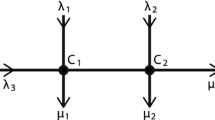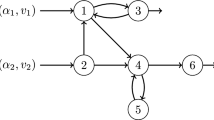Abstract
Two traffic streams Φ1, Φ2 are offered a link. The calls of Φ i require exponential holding times with parameter μ and are accepted if less than C i trunks are occupied. Approximating the Φ i by appropriate renewal processes meeting their first two moments, defined as the moments of the numbers of calls in virtual links of infinite capacity to which the traffic streams as freed traffics are virtually directed and where the calls get fresh exponential i.i.d. holding times with parameter μ, stable recursive algorithms of complexity O(max (C1,C2)) are derived for the first two defined as above moments of the individual overflow and freed carried traffics. The results offer a unified handling of both overflow and carried traffics in circuit switched networks with trunk reservation, providing a basis for new two-moment network dimensioning algorithms.
Similar content being viewed by others
References
N.G. Bean, R.J. Gibbens and S. Zachary, Asymptotic analysis of single resource loss systems in heavy traffic, with applications to integrated networks. Adv. Appl. Probab. 27(1) (1995) 273–292.
S.C. Borst and D. Mitra, Virtual partitioning for robust resource sharing: Computational techniques for heterogeneous traffic. IEEE J. Sel. A. Comm. 16(5) (1998) 668–678.
A. Brandt and M. Brandt, Approximation for overflow moments of a multiservice link with trunk reservation. Performance Evaluation 43 (2001) 259–268.
A. Brandt and M. Brandt, On the moments of the overflow and freed carried traffic for the GI/M/C/0 system. Methodology and Computing in Appl. Probab. 4 (2002) 69–82.
A. Brandt, P. Franken and B. Lisek, Stationary Stochastic Models, (Akademie-Verlag, Berlin; Wiley, Chichester, 1990).
CCITT, Recommendation E.524. The International Telegraph and Telephone Consultative Committee (CCITT), Geneva (1992) pp. 1–11.
P.J. Deschamps, Analytic approximation of blocking probabilities in circuit switched communication networks. IEEE Trans. on Comm. COM-27(3) (1979) 603–606.
E.A. van Doorn, Some analytical aspects of the peakedness concept, in Proc. 10th Int. Teletraffic Cong. Montreal 1983. Extended version: Some aspects of the peakedness concept in teletraffic theory, J. of Inf. Processing and Cybernetics (Elektron. Inf. verarb. Kybern.) EIK 22(2/3) (1986) 93–104.
P. Franken and J. Kerstan, Bedienungssysteme mit unendlich vielen Bedienungsapparaten, in: Operationsforschung und mathematische Statistik I, (Akademie-Verlag, Berlin, 1968) pp. 67–76.
A. Girard, Routing and Dimensioning in Circuit-Switched Networks, (Addison-Wesley, Reading, 1990).
H. Heffes and J.M. Holtzman, Peakedness of traffic carried by a finite trunk group with renewal input, Bell System techn. J. 52 (1973) 1617–1642.
S. Katz, Statistical performance analysis of switched communications networks, Proc. 5th Int. Teletraffic Cong. (1967) 566–575.
R.S. Krupp, Stabilization of alternative routing networks, in: Proceedings of the IEEE International Communications Conference (1982) 31.2.1–31.2.5.
A. Kuczura, The interrupted Poisson process as an overflow process, Bell System techn. J. 52 (1973) 437–448.
A. Kuczura and D. Bajaj, A method of moments for the analysis of a switched communication network’s performance, IEEE Trans. on Comm. COM-25(2) (1977) 185–193.
D.R. Manfield and T. Downs, Decomposition of traffic in loss systems with renewal input, IEEE Trans. on Comm. COM-27(1) (1979) 44–58.
The Network Dimensioning Tool NERT (Siemens AG Munich).
M.I. Reiman, Optimal trunk reservation for a critically loaded link. Teletraffic and datatraffic in a period of change, ITC-13 (1991) 247–252.
L. Reneby, Service protection and overflow in circuit switched networks. Thesis, Technical Report No. 107, Department of Communication Systems, Lund Institute of Technology, Lund (1991) 1–197.
J.W. Roberts, Teletraffic models for the telecom 1 integrated services network, in Proc. 10th Int. Teletraffic Cong. (Montreal 1983).
J.W. Roberts, U. Mocci and J. Virtamo, (eds.), Broadband Network Teletraffic: Performance Evaluation and Design of Broadband Multiservice Networks. Final report of action COST 242. Lecture notes in computer science, vol. 1155 (Springer-Verlag, Berlin, 1996).
K.W. Ross, Multiservice Loss Models for Broadband Telecommunication Networks. (Springer, London, 1995).
L. Takacs, Introduction to the Theory of Queues (Oxford University Press, New York, 1962).
R.I. Wilkinson, Theories for toll traffic engineering in the U.S.A. Bell System Techn. J. 35 (1956) 421–514.
Author information
Authors and Affiliations
Additional information
This work was supported by a grant from the Siemens AG.
Rights and permissions
About this article
Cite this article
Brandt, A., Brandt, M. Individual Overflow and Freed Carried Traffics for a Link with Trunk Reservation. Telecommun Syst 29, 283–308 (2005). https://doi.org/10.1007/s11235-005-3270-2
Received:
Revised:
Issue Date:
DOI: https://doi.org/10.1007/s11235-005-3270-2




